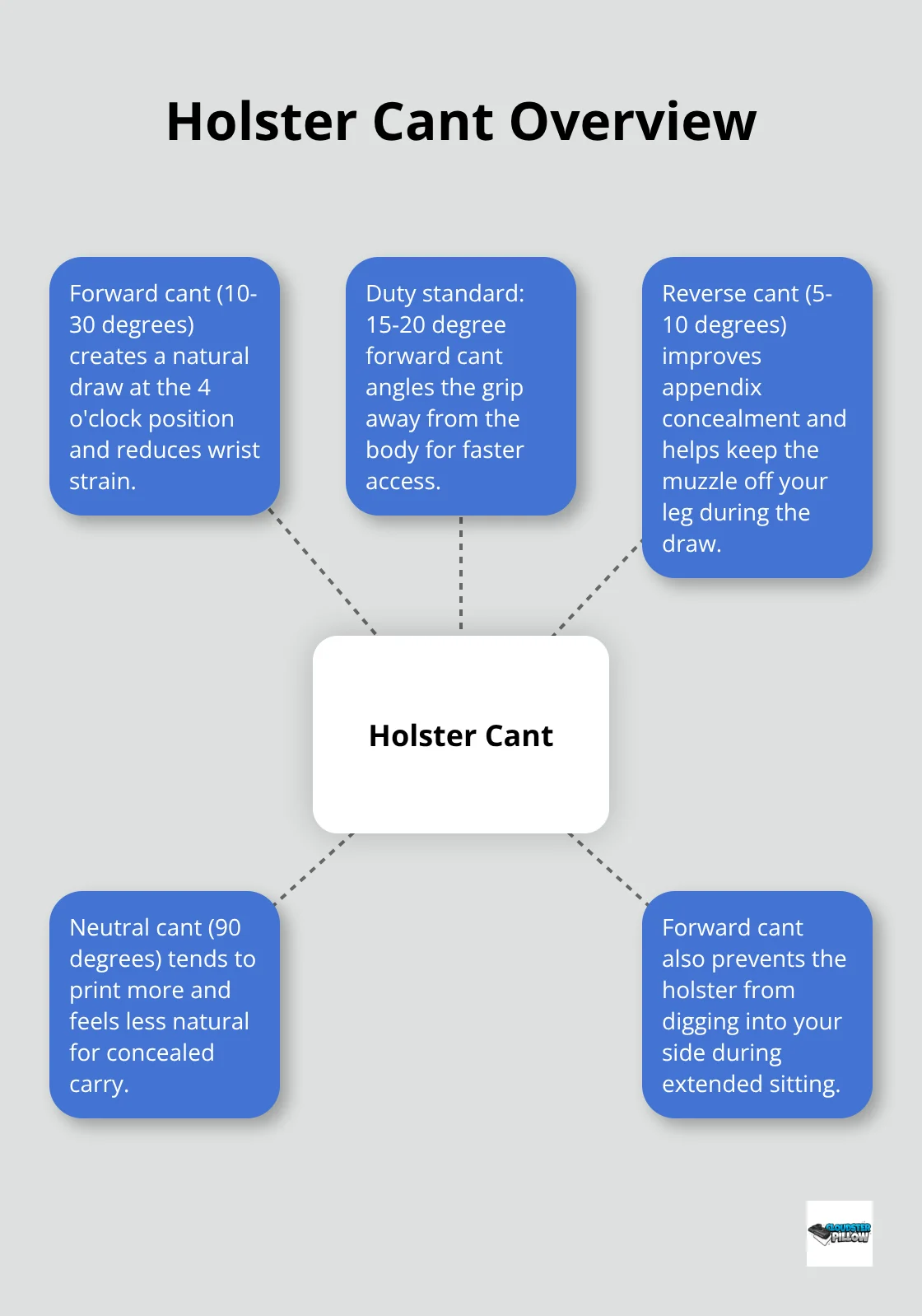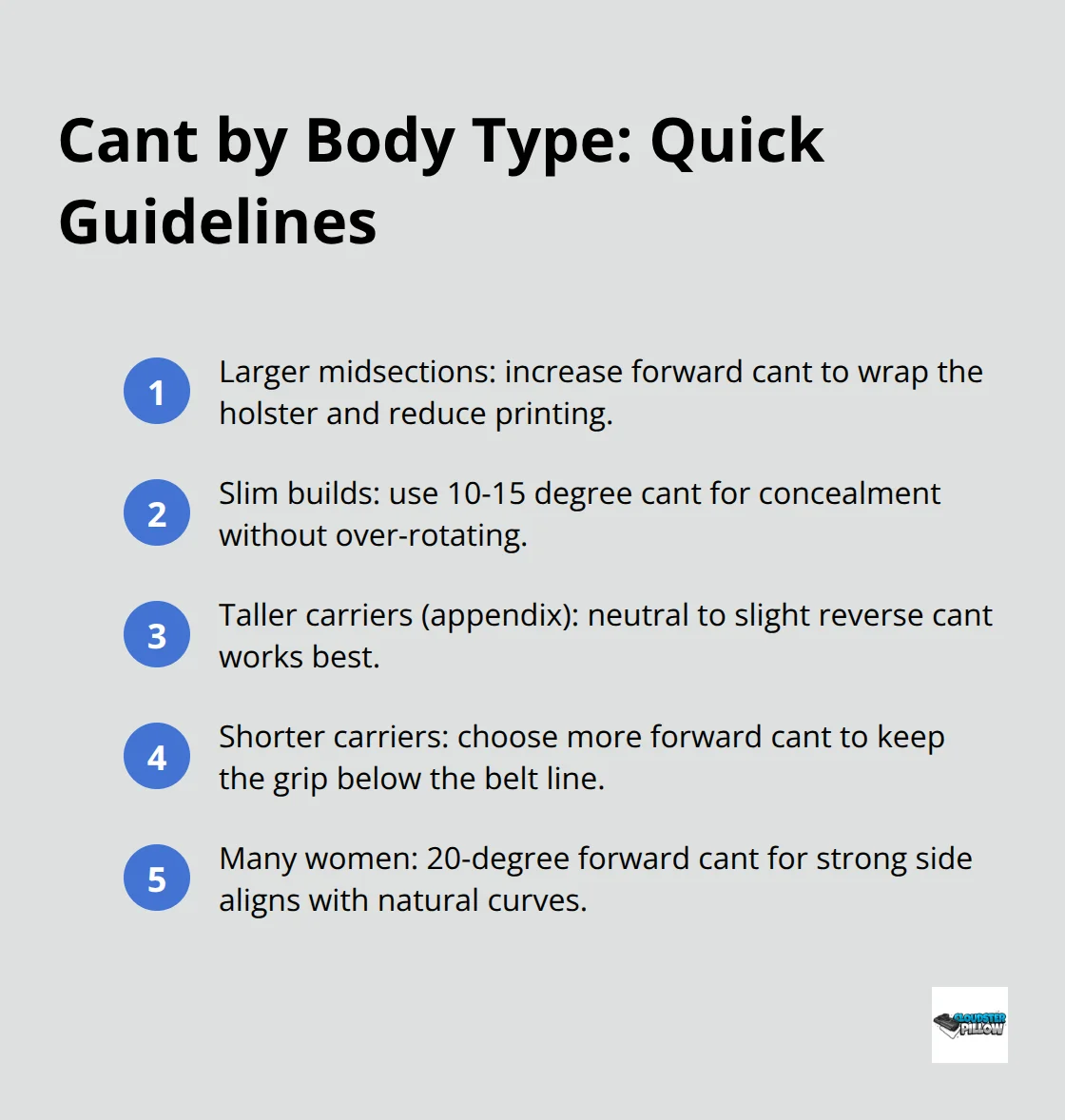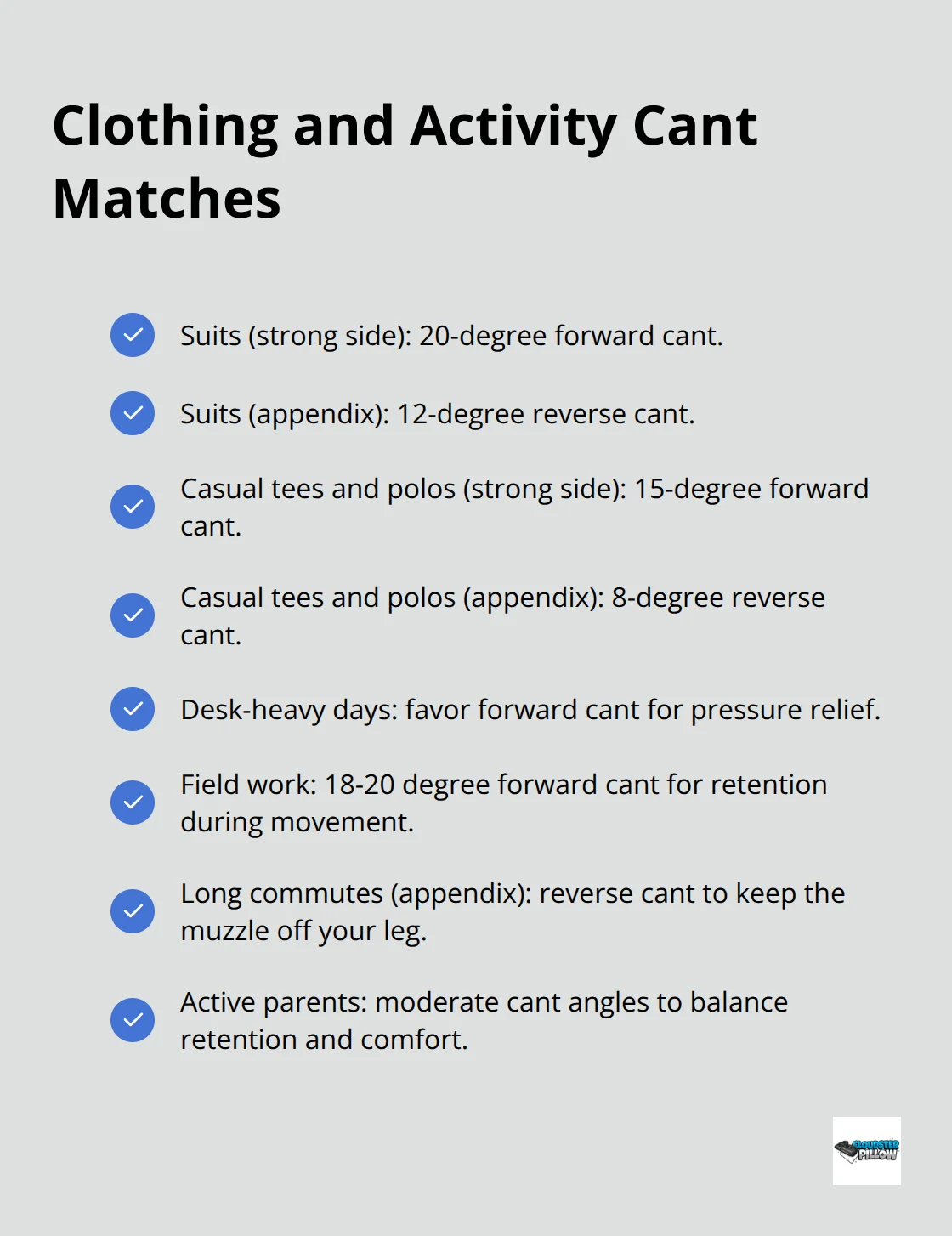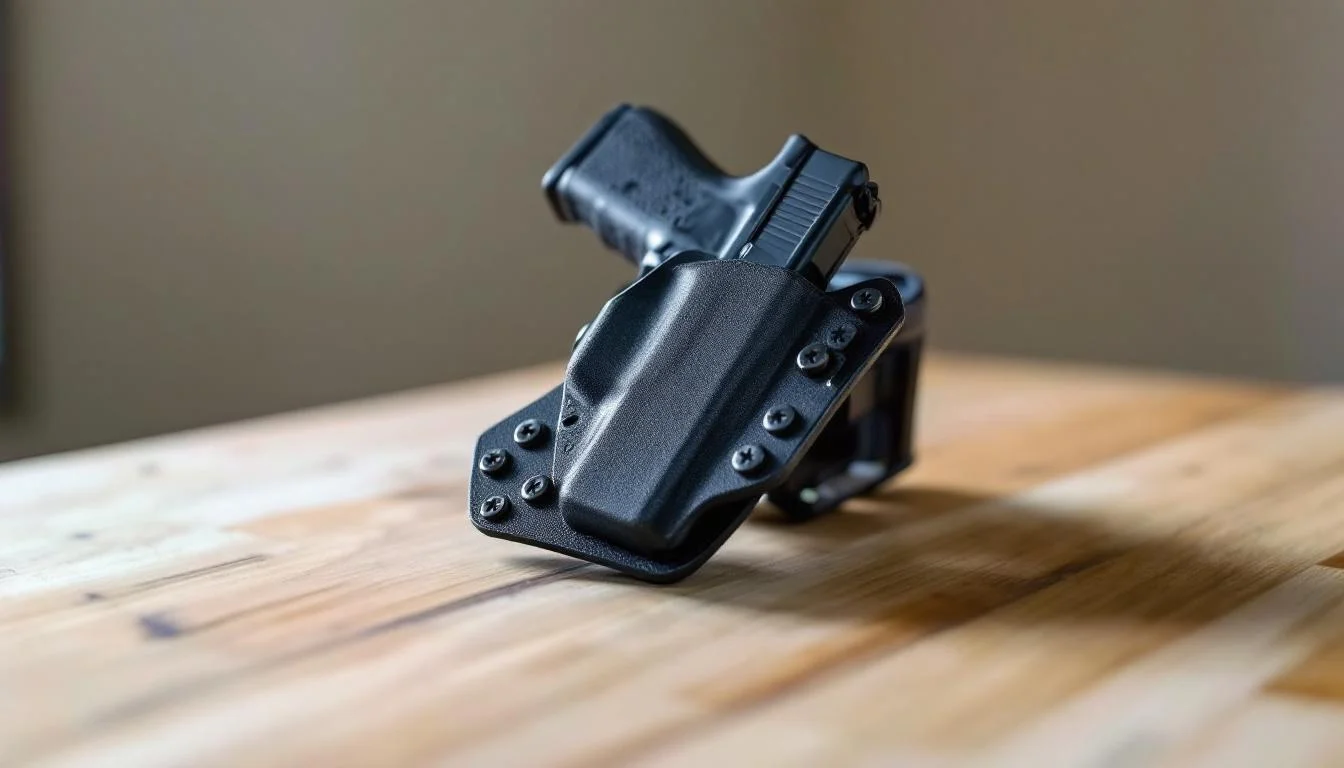Firearm Tips and Tricks
Understanding Holster Cant and Why It Matters for CCW
Holster cant determines how your firearm sits against your body and directly impacts both concealment and draw efficiency. Most carriers overlook this critical adjustment, missing opportunities to improve their everyday carry experience.
We at Cloudster Pillow see countless carriers struggling with printing issues and uncomfortable positioning simply because they haven’t optimized their cant angle for their specific needs and body type.
What Exactly Is Holster Cant
Holster cant measures the forward or backward angle of your holster relative to a straight vertical position. Law enforcement professionals typically favor a 15-20 degree forward cant, which allows the grip to angle away from the body for faster access.
Neutral cant sits perfectly vertical at 90 degrees, while reverse cant tilts the grip toward your body. Appendix carry positions commonly use reverse cant for better concealment.
Forward Cant Mechanics
Forward cant positions between 10-30 degrees create the most natural draw stroke for strong side carry at the 4 o’clock position. The angled grip aligns with your arm’s natural reach and reduces wrist strain during the draw.

Studies from firearms training academies show that forward cant reduces draw time compared to neutral positions. This angle also prevents the holster from digging into your side during extended sitting periods.
Reverse Cant Applications
Reverse cant works best for appendix carry and cross-draw positions. The grip angles inward toward your centerline, which improves concealment under fitted clothing by tucking the grip closer to your body.
Competitive shooters often prefer 5-10 degrees of reverse cant for appendix carry, as it reduces printing while maintaining quick access. The inward angle also prevents the muzzle from pointing at your leg during the draw stroke (improving safety protocols for AIWB carriers).
Neutral Cant Limitations
Neutral cant offers limited benefits for concealed carry applications. The vertical position creates more printing under clothing and provides less natural draw mechanics compared to angled positions.
Open carry situations may benefit from neutral cant at the 3 o’clock position, but concealed carriers typically find better results with forward or reverse angles. The straight vertical position also increases pressure points against your body during movement.
Understanding these cant fundamentals sets the foundation for optimizing your concealment and comfort throughout your daily activities.
How Cant Affects Your Daily Carry Experience
Cant angle controls how much your firearm prints through clothing and affects your comfort during extended carry periods. A forward cant position distributes weight more evenly across your belt line and moves the grip closer to your body’s natural curve, which prevents the telltale bulge that reveals your firearm under fitted shirts or jackets.
Comfort During Extended Sitting
Forward cant between 10-20 degrees prevents the holster from jabbing into your ribs during car rides and desk work. Law enforcement officers report significantly less discomfort during 8-hour shifts when they use FBI cant compared to neutral positions. The forward angle allows your firearm to settle naturally against your body rather than create pressure points that develop into painful hot spots.
Reverse cant works better for appendix carriers who spend long hours seated, as it keeps the muzzle from pressing into your thigh while it maintains quick access. Office workers and drivers find this angle reduces fatigue and eliminates the constant need to adjust their position.
Body Type Considerations
Larger midsections benefit from increased forward cant angles, which wraps the holster around the body’s contour and reduces printing. Slim builds can use less aggressive cant angles around 10-15 degrees without they sacrifice concealment effectiveness.

Taller carriers often prefer neutral to slight reverse cant for appendix positions, while shorter individuals need more aggressive forward cant to prevent the grip from extending above their belt line. Women typically require different cant adjustments due to hip placement and clothing fit (with many preferring 20-degree forward cant for strong side carry to work with their body’s natural curves).
Movement and Activity Impact
Active lifestyles demand cant angles that accommodate bending, reaching, and physical movement without they compromise concealment or comfort. Forward cant maintains better retention during physical activity because it aligns with your body’s natural motion patterns.
The right cant angle becomes even more important when you consider how different clothing styles and daily activities interact with your carry position and holster choice.
Which Cant Works Best for Your Carry Position
AIWB Cant Requirements
Appendix carry demands reverse cant between 5-15 degrees for optimal concealment and safety. This inward angle tucks the grip against your body while it prevents the muzzle from pointing at your femoral artery during the draw stroke.
Competitive USPSA shooters consistently choose 8-12 degrees of reverse cant for appendix positions because it maintains the fastest draw times while it keeps the firearm invisible under business attire. Taller individuals need more aggressive reverse cant up to 15 degrees, while shorter carriers perform better with 5-8 degrees to prevent the grip from extending above their belt line.
Strong Side Carry Optimization
Strong side carry at 4 o’clock requires 10-15 degrees of forward cant for maximum effectiveness. The forward angle aligns with your arm’s natural reach and prevents the holster from digging into your ribs during extended sitting.
Business professionals who carry strong side need 20-degree forward cant to work effectively with suit jackets and dress shirts. Casual clothing allows for 15-degree cant without it compromises concealment. Active individuals benefit from 18-degree forward cant because it maintains retention during physical movement while it reduces pressure points that develop during long carry periods.
Clothing and Activity Matching
Fitted clothing requires more aggressive cant angles to prevent printing, while loose garments allow for moderate adjustments. Suit wearers need 20-degree forward cant for strong side or 12-degree reverse cant for appendix to work with tailored fits (especially when sitting frequently in meetings or at desks).

Casual polo shirts and t-shirts perform well with 15-degree forward cant or 8-degree reverse cant depending on carry position. Office workers who sit frequently benefit from forward cant angles, while field workers need cant positions that accommodate bending and reaching movements without they compromise retention or comfort.
Daily Activity Considerations
Your daily routine determines which cant angle serves you best throughout extended carry periods. Desk workers find forward cant reduces pressure during 8-hour workdays, while warehouse employees need angles that maintain concealment during physical labor (typically 18-20 degrees forward for strong side positions).
Drivers benefit from reverse cant for appendix carry because it prevents the muzzle from pressing into their leg during long commutes. Parents who frequently bend down to pick up children perform better with moderate cant angles that maintain retention without they create uncomfortable pressure points during constant movement.
Final Thoughts
The right holster cant transforms your concealed carry experience from uncomfortable compromise to confident daily routine. Your body type, carry position, clothing choices, and daily activities all determine which cant angle serves you best. Forward cant between 10-20 degrees works for most strong side carriers, while reverse cant of 5-15 degrees optimizes appendix positions.
Proper holster cant eliminates print issues, reduces pressure points during extended wear, and creates natural draw mechanics that improve both speed and safety. The difference between an uncomfortable setup and confident carry often comes down to finding your optimal cant angle through experimentation and adjustment. Most carriers discover their ideal angle within the first week of testing different positions.
Even with perfect cant positioning, comfort accessories make the difference between tolerable carry and all-day confidence (especially during long workdays or extended activities). We at Cloudster Pillow designed our holster wedge to enhance concealment and comfort for both AIWB and IWB positions. The right combination of proper cant and quality comfort accessories creates a carry system that feels natural throughout your daily routine.


